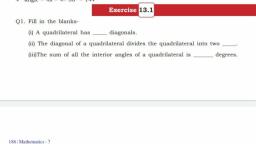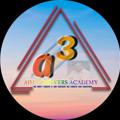Question 1 :
The measure of an angle of a parallelogram is $70^0$. Find its remaining angles.
Question 2 :
Explain how a square is a parallelogram<br/><br/><b>Answer: </b>A square has its opposite sides parallel, so, it is a parallelogram.<br/>
Question 3 :
State true or false:<br/>In a parallelogram, the diagonals intersect at right angles
Question 4 :
In a quadrilateral ABCD, $\angle A + \angle C = 180^{\circ}$ then $\angle B + \angle D = $
Question 5 :
State whether the given Question is True or False?The diagonals of a parallelogram bisect each other.
Question 6 :
Fill in the blank:<br/>Line joining the mid-points of any two sides of a triangle is _____ to the third side.<br/>
Question 7 :
Three vertices of a parallelogram are $(a+b,a-b), (2a+b, 2a-b), (a-b, a+b)$. Find the fourth vertex.
Question 8 :
The four angles of a quadrilateral are as $3 : 5 : 7 :9$. Find the angles<br/>
Question 10 :
Fill in the blanks:<br/>(i) The ling segment joining a vertex of a triangle to the midpoint of its opposite side is called a $\underline { P } $ of the triangle.<br/>(ii) The perpendicular line segment from a vertex of a triangle to its opposite is called an $\underline { Q } $ of the triangle<br/>(iii) A triangle has $\underline { R } $ altitudes and $\underline { S } $ medians
Question 11 :
If a line divides any two sides of a triangle in the same ratio, then the line is parallel to the _______ side.<br/>
Question 12 :
If the perimeter of a parallelogram is $50$ cm and one side is $12$ cm. what is the measure of the other side ?
Question 13 :
Area of the parallelogram formed by the lines<br>$y=mx, y=mx+1, y=nx$ and $y=nx+1$ equals<br>
Question 14 :
One side of a parallelogram is 8 cm. If thecorresponding altitude is 6 cm, then its area is given by
Question 15 :
If an angle of a parallelogram is 24$^o$ less than twice the smallest angle, then the value of largest angle of the parallelogram is
Question 16 :
What is the maximum possible area of a parallelogram with one side of length 2 meters and a perimeter of 24 meters ?
Question 17 :
The measure of an angle of a parallelogram is $70^0$. Find its remaining angles.
Question 18 :
In a square ABeD, its diagonals bisect at O. Then the triangleAOB is
Question 19 :
The dimensions of rectangular field are $23x-10$ and $14x+8$ units. The values of $x$ for which it would be square is
Question 20 :
Three vertices of a parallelogram taken in order are $( - 1 , - 6 ) , ( 2 , - 5 )$ and $(7,2).$ The fourth vertex is :
Question 21 :
Match the following.<table class="wysiwyg-table"><tbody><tr><td>$(1)$ Rectangle</td><td>(p) A quadrilateral having its opposite sides equal and parallel.</td></tr><tr><td>$(2)$ Square</td><td>(q) A parallelogram having its opposite sides equal and each of the angle is a right angle.</td></tr><tr><td>$(3)$ Parallelogram</td><td>(r) A parallelogram having all sides equal and each of the angle is a right angle.</td></tr><tr><td>$(4)$ Rhombus</td><td>(s) A quadrilateral in which a pair of opposite sides are parallel.</td></tr><tr><td>$(5)$ Trapezium</td><td>(t) A parallelogram having all sides equal.</td></tr></tbody></table>
Question 22 :
Can the angles $110^o, 80^o, 90^o$ & $105^o$ be the angles of quadrilateral?
Question 23 :
State true or false:A diagonal divides a parallelogram into two triangles of equal areas.
Question 24 :
The angle of a quadrilateral are respectively $120^o, 73^o, 80^o$. Find the fourth angle
Question 26 :
What is the minimum possible perimeter of a quadrilateral with an area of $1,600$ square feet?
Question 28 :
The perimeter of a parallelogram is ...................... when the sides are $12$ cm and $5$ cm.
Question 30 :
PQRS is a parallelogram and $\angle 1$ and $\angle 2$ are two exterior,angles, then $\angle 1=\angle 2=\angle 3=\angle 4$
Question 32 :
A quadrilateral has distinct integer side lengths. If the second-largest side has length $10$,then the maximum possible length of the largest side is<br>
Question 33 :
State true or false:<br/>In quadrilateral ABCD, the diagonals AC and BD intersect each each other at right angle, then $ AB^2 + CD^2 = AC^2 + DA^2$<br/><br/>
Question 34 :
The diagonals of rhombus are $24$ cm and $10$ cm. Then its perimeter is:
Question 36 :
If two parallel lines are cut by two distinct transversals, then the quadrilateral formed by these four lines will always be a:
Question 37 :
The adjacent sides of a parallelogram are 15 cm and 10 cm. If length of one diagonal of this parallelogram is 20 cm, the length of other diagonal will be
Question 38 :
In a quadrilateral $ABCD$, the angles $\angle A, \angle B, \angle C$ and $\angle D$ are in the ratio $2 : 3 : 4 : 6$. Find the measure of each angle of the quadrilateral
Question 40 :
State 'true' or 'false'The diagonals of a trapezium bisect each other.<br/>
Question 41 :
Which of the following is correct regarding the diagonals of a rhombus ?
Question 42 :
ABCD is a rectangle such that $AC+AB=5 AD$ and $AC-AD=8$, then the area of rectangle ABCD is 
Question 43 :
There exists a quadrilateral with a rotational symmetry of the order more than 1 but doesn't have a line symmetry.
Question 44 :
A quadrilateral-shaped photo-frame has all sides equal. Which of the following is not a possible shape for the photo-frame.
Question 46 :
The adjacent angles of a parallelogram are as 2 : 3.Find the measures of all the angles
Question 47 :
Name the quadrilaterals whose diagonals bisect each other<br/><br/><b>Answer: </b>Parallelogram; rhombus; square; rectangle.<br/>
Question 48 :
A quadrilateral whose each angle is a right angle is a
Question 49 :
Two consecutive angles of parallelogram are in the ratio 1 : 3 Then the smaller angle is
Question 50 :
Two parallelograms stand on equal bases and between the same parallels. The ratio of their areas is

































